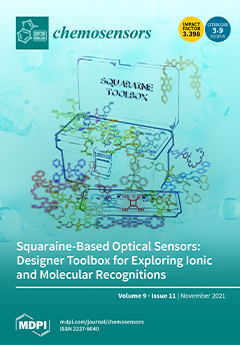This paper’s emphasis is on the development of a fluorescent chemosensor for Fe
3+ ions in an aqueous solution, using hydrophilic carbon dots (
O-CDs). A simple, cost-effective, and environmentally friendly one-step hydrothermal synthesis method was used to synthesize fluorescent hydrophilic
O
[...] Read more.
This paper’s emphasis is on the development of a fluorescent chemosensor for Fe
3+ ions in an aqueous solution, using hydrophilic carbon dots (
O-CDs). A simple, cost-effective, and environmentally friendly one-step hydrothermal synthesis method was used to synthesize fluorescent hydrophilic
O-CDs from
Oxalis corniculata (Family; Oxalidaceae). The graphitic structure and size distribution of the
O-CDs was verified by X-ray diffraction, Raman spectroscopy, and high-resolution transmission electron microscopy studies. The resulting
O-CDs had a near-spherical shape and an adequate degree of graphitization at the core, with an average diameter of 4.5 nm. X-ray photoelectron and Fourier transform infrared spectroscopy methods revealed the presence of several hydrophilic groups (carbonyl, amine, carboxyl, and hydroxyl, along with nitrogen and oxygen-rich molecules) on the surface of
O-CDs. The synthesized hydrophilic
O-CDs with excitation wavelength-dependent emission fluorescence characteristics showed a high quantum yield of about 20%. Besides this, the hydrophilic
O-CDs exhibited a bright and controllable fluorescence with prolonged stability and photo-stability. These fluorescent hydrophilic
O-CDs were used as a nanoprobe for the fluorometric identification of Fe
3+ ions in an aqueous solution, with high sensitivity and selectivity. By quenching the blue emission fluorescence of this nanosensor, a highly sensitive Fe
3+ ion in the range of 10–50 µM with a minimum detection limit of 0.73 µM was achieved. In addition, the developed nanosensor can be used to sense intracellular Fe
3+ ions with high biocompatibility and cellular imaging capacity, and it has a lot of potential in biomedical applications.
Full article





